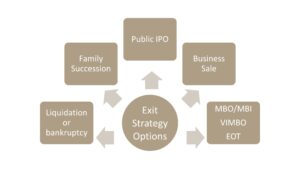The shadow chancellor is being lobbied heavily to increase Capital Gains Tax (“CGT”). Under the current system, profits from the sale of second homes or shares in businesses are taxed at a much lower rate than wages. For some, the prospect of a CGT increase is a driver for sale and for others, it is the adventure of retirement – or as one former client put it, “I was born to not work and I am good at it, there is so much to do!” Whatever your motivation is for selling, there are a variety of ways to facilitate your exit strategy, ranging from trade buyers to private equity or employee ownership. So, which alternative will best suit you and or your team?
Exit Strategy Types
Different people start companies for different reasons, and that invariably influences their exit strategy. Each owner’s journey is different as each company’s shareholder dynamics are different. The right exit strategy or option depends a lot on your objectives and below we summarise the options you might consider, either alone or in combination with other alternatives:
| Wind down and liquidation | Whilst this may, at first, seem negative, building up reserves and liquidating the business can be tax-effective. Additionally, if recurring revenue creates an annuity, the business can be left to build up reserves before the eventual liquidation. A liquidation can, of course, also occur when things go wrong. |
| Family succession | Gifting shares to the next generation or a sale to family members, often over time, allows them to develop and build their experience within the business. |
| Family inheritance | Shares in a private company can be inheritance tax-free therefore passing on shares on death can be an important part of succession planning. The thinking behind this is why sell now to secure cash that might not be required only to have your beneficiaries pay large amounts of inheritance tax later on? There is family tax planning scope on shares in most countries. |
| The managed business | Moving an enterprise from owner-driven to team-driven can create significant free time for the owners, whilst continuing to benefit from income from the business. This can facilitate an initial exit perhaps followed later by a full sale. Team-driven businesses with a good growth track record and ongoing prospects can be highly valuable. The strategy requires training investment in the management team. Just delegating to the team with insufficient succession planning can create a void in leadership. |
| Flotation – an initial price offering (“IPO”) | From the Alternative Investment Market to the FTSE or NASDAQ globally there is a myriad of publicly listed businesses controlled by management but with shares on the listed exchange enabling a sale and realisation of the business directly to the public. This approach usually only suits larger businesses prepared to deal with the significant responsibilities and administration that go with a flotation. They are rarely full exits as owners are expected to share the risks when a business ‘floats. |
| Management Buy Outs (MBO)
|
Where management acquires the business; usually assisted by leveraged debt and the vendor, there can be a conflict of interest in the process. This is because management working to grow the business are increasing their price against themselves at, they work. A strong strategic trade deal will normally beat the value which may be held in check by the amount that needs to be borrowed by the buyout team. The management team knows the business and can be agile, a seller perhaps more flexible on deal structure and due diligence is usually lighter. |
| MBI | As above, a management buyout but where the management is brought in specifically to carry out the transaction. |
| Vendor Initiated Management Buyout
(VIMBO) |
As above, a management buyout but initiated by the vendor who usually drives the process, both starting the dialogue and, usually with advisers, coaching the deal through. |
| Brought In Management Buy Out (BIMBO) | As above, a management buyout but on this occasion initiated by external management or possibly by an investment house backing external management. |
| Employee Ownership Trust- UK
(EOT)
Employee Stock Ownership Plan – USA (ESOP) |
Following the lead of companies like John Lewis with its Partnership approach to ownership, many countries have developed employee ownership company structures. If you own a trading company, you exit by selling the business to all the employees via a Trust. It is different from an MBO in the way that it is all employees, although a management board may be established with greater incentives and shares. The sale will be at arm’s length with the value set by an independent analyst. The approach works well where management is capable of acquisition but does not want to fully take on the debt personally required to affect a buy-out. The vendors, along with banks, will normally help finance the transaction. |
| Merger or Acquisition (M&A) – Trade sale or merger
|
From outright trade sales to mergers, the approach is to secure a transaction via research usually to a larger or similar company. A deal that aims at the four corners of M&A of a shareholder value gain for the buyer, synergy, economies of scale, and positive disruption to the market will nearly always secure the best value for the company. For the acquirer, it is often a quicker way to grow their revenue than creating new products. Multiple arbitrage may also motivate sales – the idea of a future sale of the combined companies at an even greater value than each may get individually. A trade sale is often considered the pinnacle exit strategy as with the right buyer and process in place, the premium is usually the highest and the deal structure the simplest. |
| Financial Sale and/or Private Equity | Businesses create yields and many good buyers are happy to buy and hold a company because of it. In recent years, as investors seek returns, this approach has increased, particularly with the advent of Private Equity houses. They are usually seeking fast-growth businesses where they can triple their initial investment or more using their capital and knowledge of how to develop the business. Sellers may be attracted to stay involved and enjoy a second exit of a smaller retained but often more valuable percentage. |
| Planned Partial exit | In this approach, we may have a blend of others although the key basis is that the sellers are actively choosing to retain a stake, either passively to perhaps enjoy their ‘retirement’ as a chairman, or proactively whilst they retain involvement and work with a new team, possibly with Private Equity backing to grow the business to the next level. |

Choosing which exit is right depends on the circumstances, market conditions, your business, and any future role you may seek in the business.
The value of an exit strategy
The exit price and deal structure should meet the shareholders’ aspirations to create future options for their journey, whilst also perhaps increasing time wealth. It is important to be objective and here we also need to remind ourselves of the value of capital and money. In our decisions as to when is the right time, we are reminded:
- Money today is worth more than its equivalent tomorrow. Money today has an opportunity value and money tomorrow is eroded against inflation.
- In many countries, the sale proceeds on shares are usually highly tax effective compared to earning income, which is typically taxed at between 40% and 50% once both corporation tax and dividend tax have been applied. In the UK at the time of writing, entrepreneurs selling their company as part of their exit strategy can claim Entrepreneurs’ Relief, reducing the Capital Gains Tax payable to just 10%. To be eligible, a shareholder must have a 5% or more shareholding in a qualifying business and have been involved with a company as an employee or director for one year or more. Every UK resident has a lifetime allowance of £1,000,000 in gains that will be taxed at this reduced rate of 10%. Be aware this is likely to change.
- Money in the hand today is worth more than money promised tomorrow as there is a risk that tomorrow’s money may not arrive. Therefore, ‘capital is more certain than income’ and with capital, you can create other yields and invest in other businesses which should further compound over time.
Conclusion
The confidentiality process employed in the sale of private companies can leave a shroud of mystery over the exit process. The consequence is the exit strategy receives too little attention and there can be significant misconceptions. Occasionally, value expectations are further distorted either by advisers seeking large engagement fees and therefore over-inflating values, or some exceptional headline deals that make the press, however, not selling the business at the right time is market disruptive.
Undertaking a business sale or succession is one of the most important financial decisions a leader or owner will ever make. Experts may help you select the right exit options for your journey and achieve maximum value and the optimum exit strategy. Research and choose advisers based on their track record, understanding, and fees linked to deliverables. Seek advice early on.
Contact us:
If you would like to see more information about our service offering and case studies on our recent deals, please visit our website at https://avondale.co.uk. Alternatively, if you would be interested in a free consultation with one of Avondale’s experienced M&A advisors, please call us at +44 (0)1737 240888, email us at av@avondale.co.uk or fill out the attached form and we will get in touch straight away.






